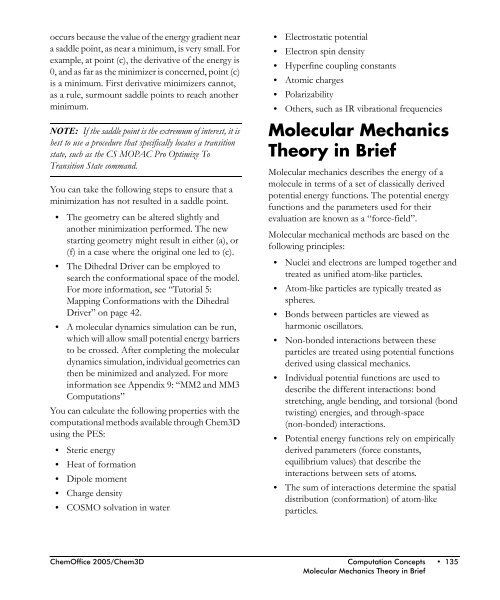Chem3D Users Manual - CambridgeSoft
Chem3D Users Manual - CambridgeSoft
Chem3D Users Manual - CambridgeSoft
You also want an ePaper? Increase the reach of your titles
YUMPU automatically turns print PDFs into web optimized ePapers that Google loves.
occurs because the value of the energy gradient near<br />
a saddle point, as near a minimum, is very small. For<br />
example, at point (c), the derivative of the energy is<br />
0, and as far as the minimizer is concerned, point (c)<br />
is a minimum. First derivative minimizers cannot,<br />
as a rule, surmount saddle points to reach another<br />
minimum.<br />
NOTE: If the saddle point is the extremum of interest, it is<br />
best to use a procedure that specifically locates a transition<br />
state, such as the CS MOPAC Pro Optimize To<br />
Transition State command.<br />
You can take the following steps to ensure that a<br />
minimization has not resulted in a saddle point.<br />
• The geometry can be altered slightly and<br />
another minimization performed. The new<br />
starting geometry might result in either (a), or<br />
(f) in a case where the original one led to (c).<br />
• The Dihedral Driver can be employed to<br />
search the conformational space of the model.<br />
For more information, see “Tutorial 5:<br />
Mapping Conformations with the Dihedral<br />
Driver” on page 42.<br />
• A molecular dynamics simulation can be run,<br />
which will allow small potential energy barriers<br />
to be crossed. After completing the molecular<br />
dynamics simulation, individual geometries can<br />
then be minimized and analyzed. For more<br />
information see Appendix 9: “MM2 and MM3<br />
Computations”<br />
You can calculate the following properties with the<br />
computational methods available through <strong>Chem3D</strong><br />
using the PES:<br />
• Steric energy<br />
• Heat of formation<br />
• Dipole moment<br />
• Charge density<br />
• COSMO solvation in water<br />
• Electrostatic potential<br />
• Electron spin density<br />
• Hyperfine coupling constants<br />
• Atomic charges<br />
• Polarizability<br />
• Others, such as IR vibrational frequencies<br />
Molecular Mechanics<br />
Theory in Brief<br />
Molecular mechanics describes the energy of a<br />
molecule in terms of a set of classically derived<br />
potential energy functions. The potential energy<br />
functions and the parameters used for their<br />
evaluation are known as a “force-field”.<br />
Molecular mechanical methods are based on the<br />
following principles:<br />
• Nuclei and electrons are lumped together and<br />
treated as unified atom-like particles.<br />
• Atom-like particles are typically treated as<br />
spheres.<br />
• Bonds between particles are viewed as<br />
harmonic oscillators.<br />
• Non-bonded interactions between these<br />
particles are treated using potential functions<br />
derived using classical mechanics.<br />
• Individual potential functions are used to<br />
describe the different interactions: bond<br />
stretching, angle bending, and torsional (bond<br />
twisting) energies, and through-space<br />
(non-bonded) interactions.<br />
• Potential energy functions rely on empirically<br />
derived parameters (force constants,<br />
equilibrium values) that describe the<br />
interactions between sets of atoms.<br />
• The sum of interactions determine the spatial<br />
distribution (conformation) of atom-like<br />
particles.<br />
ChemOffice 2005/<strong>Chem3D</strong> Computation Concepts • 135<br />
Molecular Mechanics Theory in Brief











